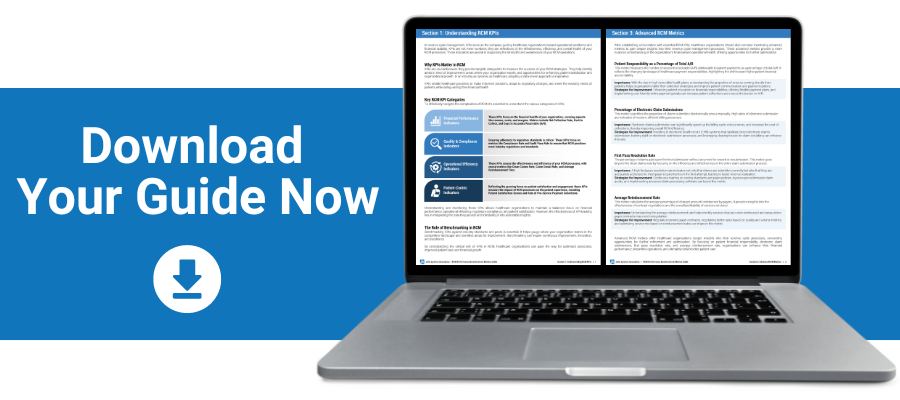

RCM Performance Benchmarks and Metrics [+Guide]
August 7, 2024Revenue cycle management (RCM) encompasses every step of the financial process in healthcare from the moment an appointment is booked through to the final payment of a bill. It integrates the business side of health with patient care, involving medical billing, coding, claims processing, and payment collection.
Achieving an efficient RCM process is not without its challenges. Healthcare organizations often grapple with denied claims, underpayments, inefficient billing processes, and the complexities of insurance verifications. These challenges underscore the need for a strategic approach to RCM, guided by key performance indicators (KPIs) and industry benchmarks.
Why KPIs Matter in RCM
In revenue cycle management, KPIs serve as the compass guiding healthcare organizations toward operational excellence and financial stability. KPIs are crucial because they provide tangible data points to measure the success of your RCM strategies. They help identify areas in need of improvement, areas where your organization excels, and opportunities for enhancing patient satisfaction and organizational growth. In an industry as dynamic as healthcare, adopting a data-driven approach is imperative.
Key RCM KPI Categories
To effectively navigate the complexities of RCM, it’s essential to understand the various categories of KPIs.
Financial Performance Indicators: These KPIs focus on the financial health of your organization, covering aspects like revenue, costs, and margins. Metrics include Net Collection Rate, Cost to Collect, and Days in Accounts Receivable (A/R).
Quality & Compliance Indicators: Ensuring adherence to regulatory standards is critical. These KPIs focus on metrics like Compliance Rate and Audit Pass Rate to ensure that RCM practices meet industry regulations and standards.
Operational Efficiency Indicators: These KPIs assess the effectiveness and efficiency of your RCM processes, with crucial metrics like Clean Claims Rate, Claim Denial Rate, and Average Reimbursement Time.
Patient-Centric Indicators: Reflecting the growing focus on patient satisfaction and engagement, these KPIs measure the impact of RCM processes on the patient experience, including Patient Satisfaction Scores and Rate of Pre-Service Payment Collections.
RCM Performance Benchmarks and Metrics Guide
Our RCM Performance Benchmarks and Metrics Guide is designed to give you an overview of the essential KPIs pivotal in assessing and enhancing the efficiency of your RCM processes. We dig into each KPI, explaining its significance, how it can be measured, and what benchmarks you should aim for to achieve RCM excellence.
Navigating the Future of RCM with Confidence
RCM optimization is an ongoing process that requires a strategic approach to address various aspects of the revenue cycle.
By focusing on key areas such as patient registration, coding practices, denial management, technological enhancements, patient financial communication, and regular audits and training, healthcare organizations can significantly improve their RCM performance.
These actionable strategies not only drive financial and operational improvements but also contribute to better patient experiences and outcomes. As healthcare continues to evolve, adopting a proactive and comprehensive approach to RCM optimization will be essential for sustaining success and growth.
At John Lynch & Associates, we understand the critical role that RCM plays in the financial health and operational efficiency of healthcare organizations.
With decades of experience in healthcare consulting, we have seen firsthand how optimized RCM processes can significantly enhance a healthcare provider’s ability to deliver quality care while maintaining financial stability.
For more information on how we can assist with your revenue cycle management needs, contact us at 623.980.8018 or connect with us here.



